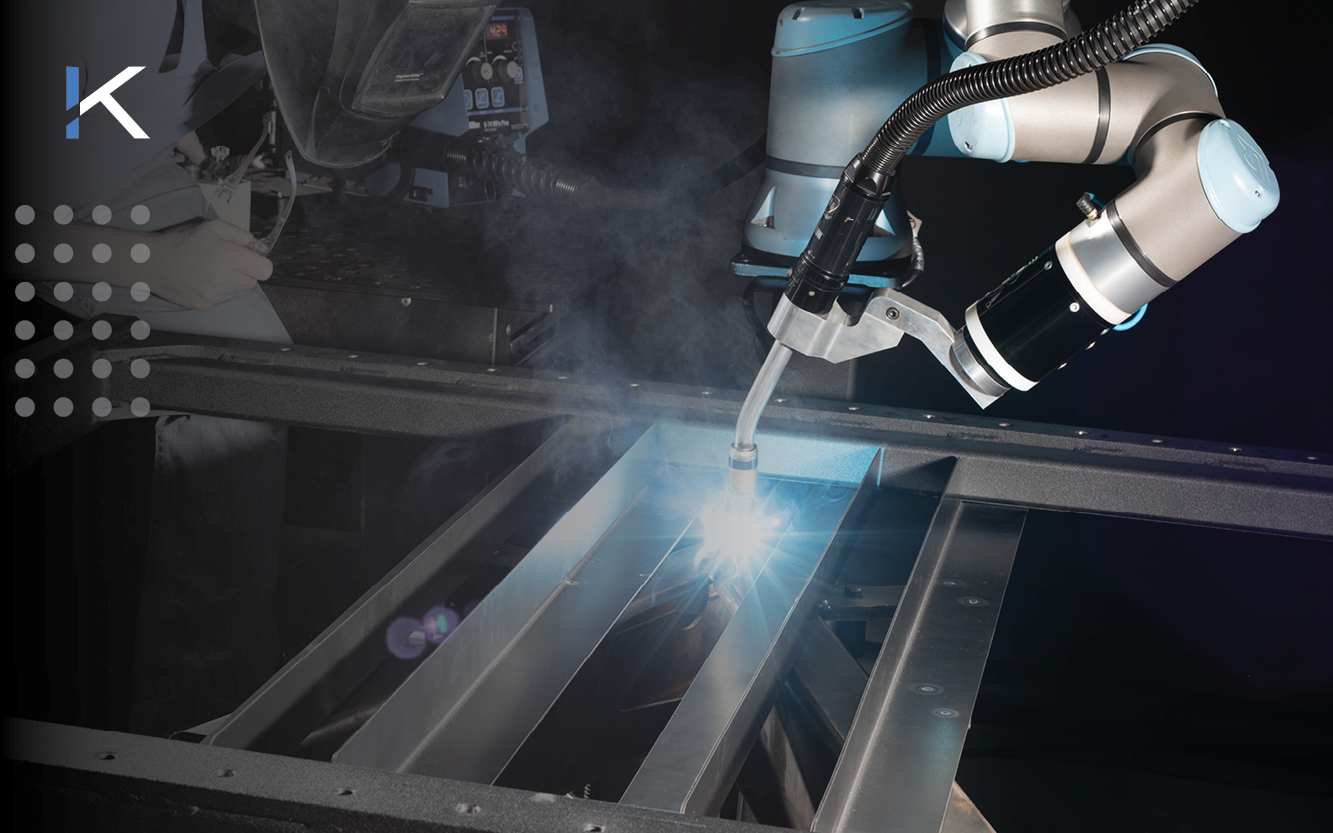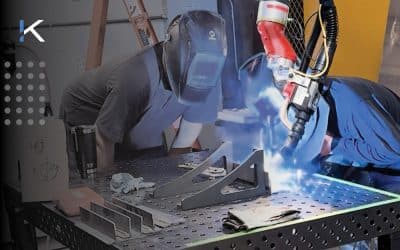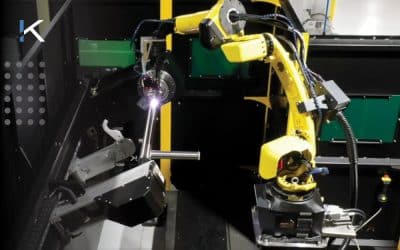Figuring out where to start with robotic welding isn’t easy. You know automation could help, but questions pile up fast—Which robot fits my needs? How do I integrate it? What processes make sense to automate?
At Kinetic Technologies, we’ve worked with manufacturers facing the same challenges. Whether it’s a labor shortage, production bottlenecks, or the need for more consistent weld quality, we help companies like yours find practical automation solutions.
This guide is your starting point. We’ll break down welding robot types, automation-ready welding processes, and key considerations so you have the tools to start planning your robotic welding project with confidence.
What is a Robotic Welding?
Robotic welding is the process of using a programmable, multi-axis robotic arm to control a welding torch and follow a predefined path to join metal parts. Robotic welding systems typically consist of more than just the robot itself.
A typical robotic welding setup includes:
- Robot Arm – A programmable, multi-axis robotic arm that moves the welding torch along a predefined path.
- Robot Controller – The unit that processes commands and controls the robot’s movement and welding parameters.
- Welding System including:
- Welding Power Supply – Provides the necessary electrical current and controls the welding parameters.
- Welding Torch – The tool that delivers the welding arc, wire (if applicable), and shielding gas to the weld joint.
- Shielding Gas System – Supplies gas (such as argon or CO₂) to protect the weld from contamination.
- Wire Feeder (if applicable) – Feeds the filler wire continuously in processes like MIG welding.
- Cooling System (if applicable) – Used in high-amperage applications to prevent overheating of the torch and components.
- Positioners or Fixtures – Holds and orients the workpieces for optimal welding angles and repeatability.
- Safety Equipment – Includes light curtains, fencing, emergency stop buttons, and sensors to ensure safe operation.
- Vision or Seam Tracking Systems (optional) – Cameras or sensors that help the robot detect and adjust to variations in the weld joint.
Robotic welding systems can deliver repeatable results with minimal variation. It’s a solution for manufacturers looking to increase throughput, improve weld quality, and address labor shortages.
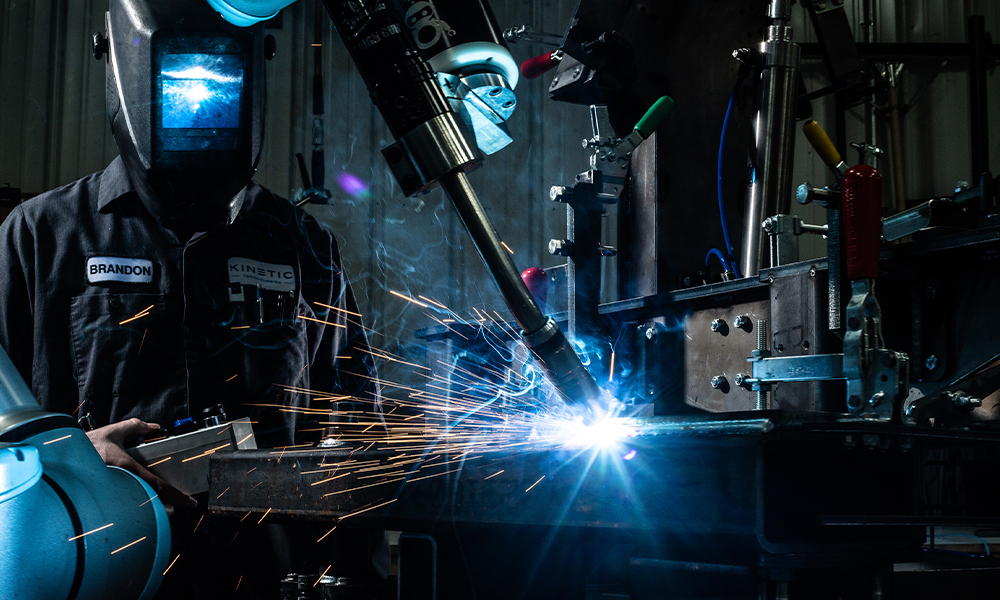
Why Robotic Welding is Important
Robotic welding is important because it addresses challenges that manual welding alone cannot solve.
It allows manufacturers to overcome labor shortages, improve consistency, and integrate automation in ways that make production more efficient without disrupting existing workflows.
The real value isn’t just in increasing output; it’s in adapting welding processes to fit specific production needs, whether by expanding a robot’s reach, improving ergonomics, or designing a system that works within existing constraints.
We’ve helped manufacturers achieve this in real-world applications.
At Modine, we solved a welder shortage and inefficiencies in high-mix, low-volume production by mounting a cobot upside-down on an overhead gantry. This increased its reach by 30%, allowing more parts to be welded in a single setup and tripling throughput within weeks.
Container Products Company (CPC) needed a safer, more efficient welding process during a major acquisition. We implemented a custom overhead robot stand with a rotary turntable embedded in the floor, making weld points more accessible and improving workflow without interrupting operations.
Robotic Welding vs Manual Welding: Advantages and Disadvantages
Before investing in robotic welding, understanding the strengths and limitations of each method can help you determine the best approach for your operations.
Advantages of Robotic Welding
- Better Productivity and Efficiency
Robotic welding systems maximize arc-on time. More arc-on time means more welding is getting done, as the machines can operate continuously without the need for breaks, leading to a significant uptick in production speed. - Consistent, High-Quality Welds
Welding robots follow precise programmed paths, ensuring repeatable, defect-free welds. This level of consistency minimizes quality variations caused by fatigue or human error. - Reduced Rework and Post-Weld Cleanup
Because robotic welding delivers accurate, controlled welds, it reduces the need for rework, grinding, or finishing. This saves time, material, and labor costs, improving overall workflow efficiency. - Safer Working Environment
Welding robots take over hazardous tasks, keeping workers away from extreme heat, harmful fumes, and sparks. This leads to a safer workplace with fewer injury-related disruptions.
Disadvantages of Robotic Welding
- Higher Initial Investment
Implementing robotic welding requires upfront costs for the robot, peripherals (positioners, safety enclosures, sensors), and training. - Requires Programming and Maintenance Expertise
Some robotic welding systems require advanced programming skills, especially traditional industrial robots with complex interfaces. Even with user-friendly options like cobots, manufacturers still need trained personnel to handle routine maintenance, troubleshoot issues, and ensure the system operates efficiently.
Advantages of Manual Welding
- Flexibility for Custom and One-Off Jobs
Skilled welders can quickly adjust their technique to accommodate complex geometries, unique materials, or repairs that robotic systems may struggle with. - Lower Initial Costs
Manual welding requires less financial outlay compared to robotic welding. Small-scale shops or those with fluctuating production demands may find manual welding more cost-effective in certain cases.
Disadvantages of Manual Welding
- Inconsistent Weld Quality
Weld quality varies based on the welder’s skill, experience, and fatigue levels. Even highly trained welders can struggle with repeatability in long production runs. - Higher Long-Term Labor Costs
Skilled welders are in short supply, and manual welding requires ongoing labor costs, including wages, training, and safety compliance. - Lower Productivity
Manual welders have limited arc-on time due to breaks, fatigue, and setup adjustments. This reduces output, making manual welding less efficient for large-scale production.
Top 4 Robotic Welding Processes
Some welding processes are better suited for automation than others, offering consistent results and efficient production. While many welding methods exist, four are most commonly integrated with robots due to their repeatability and ability to handle complex welds at scale.
- Arc Welding:
Arc welding is the most widely automated welding process, particularly in high-mix, high-volume production. Robots are commonly used for MIG (GMAW) and TIG (GTAW) welding, where consistent torch positioning and travel speed improve quality and reduce rework. Stick welding (SMAW) remains largely manual due to electrode changes and flux removal, making it less common in robotic applications. - Spot Welding:
A standard in automotive manufacturing, spot welding is one of the earliest and most adopted robotic welding applications. Robots ensure consistent pressure, precise weld placement, and repeatable cycle times—key factors in producing strong, uniform spot welds across large production runs. - Laser Welding:
Laser welding is increasingly automated in industries where traditional methods introduce too much heat or distortion. Robots integrated with laser sources can perform intricate welds on thin materials, delicate components, and reflective metals, expanding automation into aerospace, electronics, and medical device manufacturing. - Plasma Welding:
Plasma welding offers a controlled, high-energy arc similar to TIG but with greater penetration and speed. In robotic applications, it is used where precision and repeatability are critical, such as aerospace, turbine blade manufacturing, and applications requiring narrow, high-quality seams. Robotic plasma welding allows for tight process control, ensuring minimal heat distortion while maintaining deep penetration in materials that require high-strength welds.
By automating these welding processes, manufacturers can standardize weld quality, improve process control, and integrate welding automation into complex production workflows. Each method offers unique advantages when paired with robotic systems, enabling manufacturers to scale production without sacrificing precision.
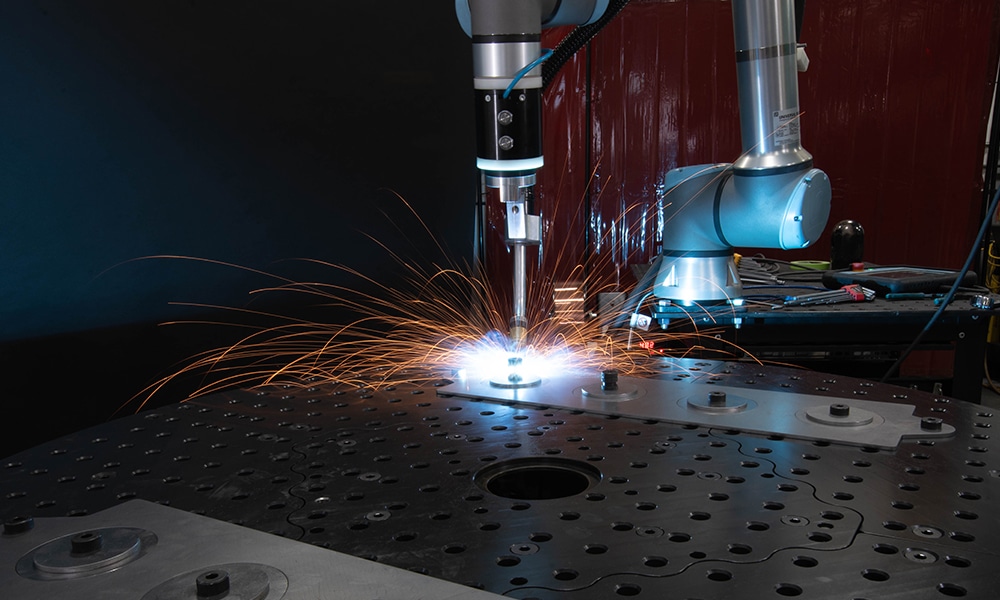
Industrial Welding Robot Manufacturers
Several manufacturers produce robot arms commonly integrated into robotic welding systems. Here are four of the most well-known brands:
- FANUC – Known for high-performance industrial welding robots, FANUC offers models like the ARC Mate series for welding and the CRX cobot line for collaborative applications.
- KUKA – Provides a range of robots suited for welding, including the KR AGILUS for compact welding setups and KR QUANTEC for heavy-duty applications.
- ABB – Offers versatile welding robots, including the IRB 2600 and IRB 6700, along with software like RobotStudio for offline programming.
- Universal Robots (UR) – Specializes in flexible cobots such as the UR10e, which integrates easily into welding applications through the UR+ ecosystem of plug-and-play accessories.
These robot arms form the core of many automated welding setups, providing the motion control and repeatability needed for consistent weld placement.
While welding robot manufacturers offer a range of models, the key differences lie in how these robots move, their precision, and their suitability for various production environments.
Types of Welding Robots
Welding robots come in different configurations, each with unique strengths based on motion control, precision, and application needs.
- 6-Axis Robots
6-axis robots are the most common in robotic welding, offering full articulation for complex weld paths and multi-position welding. They are widely used in automotive, heavy fabrication, and high-mix production environments. - SCARA Robots
SCARA (Selective Compliance Articulated Robot Arm) robots have limited vertical movement but fast, precise horizontal motion. While more common in assembly applications, they can be integrated into small-scale welding setups where speed is a priority, like electronics. - Cartesian Robots
Cartesian robots move along linear X, Y, and Z axes, providing high accuracy and repeatability for applications like long, straight welds or welding on conveyor systems. Their rigid structure makes them less flexible but ideal for structured, repetitive welding tasks. - Collaborative Robots (Cobots)
Collaborative robots or cobots bring manual guidance, built-in safety, and simplified programming to welding. They are commonly used in low-volume, high-mix production, where frequent part changes make traditional automation less practical.

Introduction to Collaborative Robots for Welding
Traditional industrial robots have long been used in welding applications, but they require safety barriers, extensive programming, and dedicated production space. Collaborative robots (cobots) offer an alternative, making automation more accessible, especially for small and mid-sized manufacturers.
- Cobots are designed to work alongside human operators with built-in force sensing and safety features that reduce the need for physical barriers.
- Their intuitive programming and compact footprint allow for easier deployment in high-mix, low-volume production environments where flexibility is key.
In welding, cobots provide a solution for businesses that need automation but lack the space or expertise for traditional robotic cells. They allow operators to set up and adjust welding paths without specialized programming skills, making them a practical option for shops looking to automate repetitive welding tasks without overhauling their entire process.
At Kinetic Technologies, we’ve seen firsthand how cobots can transform welding operations. In our work with Modine, we implemented a ceiling-mounted cobot system to maximize reach and weld multiple part variations within a single setup, increasing throughput while keeping operations flexible.
Our experience in designing, integrating, and optimizing cobot welding solutions ensures that manufacturers get systems tailored to their unique production challenges. For more real-world examples, visit our case studies.

Choosing the Right Welding Robot
Selecting the right robot for welding is crucial for improving productivity and achieving long-term success. Here’s a practical checklist to guide your selection:
Checklist for Choosing a Welding Robot
- Identify your welding needs: First, pinpoint the specific welding tasks you’re aiming to automate. Consider the materials, the complexity of the welds and potential ROI.
- Space evaluation: Assess the space you have available. Robots have varying footprints and can fit into different operational layouts.
- Flexibility requirements: Decide whether you need a robot that can adapt to a range of tasks or if it will be dedicated to specific types of welds.
- Safety considerations: Assess the safety requirements of your workplace through a detailed risk assessment. Make sure that the model you choose can be integrated with the necessary safety measures.
- Ease of operation: Assess the internal expertise your company already has or the external resources you’re willing to invest in for assistance with integration. Alternatively, consider opting for a solution that aligns with the abilities of your current workforce, ensuring a smoother adoption and integration process.
- Support and training: Look for comprehensive support and training offerings from your supplier so that your team can confidently use the robot.
- Total cost of ownership: Beyond the initial investment, consider ongoing costs like maintenance, support, and potential future upgrades. Learn how to improve your welding robot ROI to maximize long-term value.

How Kinetic Elevates Your Robotic Welding Process
Integrating a robotic welding system can be overwhelming, but with the right approach and partner, it becomes a seamless transition that improves efficiency, quality, and productivity.
Our Five-Step Process
- Consultation & Design: We assess your welding needs and develop a tailored automation plan to fit your production goals.
- Custom Components: Our in-house CNC machining and custom fabrication capabilities allow us to produce components tailored to your requirements.
- Seamless Integration: We program, test, and validate your robotic system before installation to ensure it’s production-ready.
- Onsite Installation & Training: Our team installs the system, performs final testing, and trains your operators for smooth adoption.
- Ongoing Support: We provide maintenance and troubleshooting to keep your system running at peak performance.
Your Partner in Welding Automation
At Kinetic Technologies, we focus on making the transition smooth and hassle-free. We handle the details, so you can focus on what you do best: running your business. With reliable support and practical solutions, we’re here to help you get the most out of your automation investment.
Let’s build your automation solution together. Contact our team today to get started.
FAQ: Understanding Welding Robots
Welding robots automate welding tasks, improving precision, consistency, and efficiency. They handle various welding applications across industries, reducing reliance on manual labor while ensuring high-quality welds.
Manufacturers in automotive, aerospace, construction, and metal fabrication use welding robots to increase production speed and improve weld consistency. Any business looking to improve efficiency and reduce defects can benefit from robotic welding.
While welding robots can automate many welding tasks, skilled human welders are still needed for complex welds, quality inspections, and problem-solving in dynamic production environments.
Robots greatly improve welding efficiency, often completing tasks faster and with higher precision than manual methods. Their ability to work non-stop and perform precise welds reduces waste and rework, contributing to overall operational efficiency.
Any company seeking to improve weld quality, increase throughput, or reduce labor costs can benefit. Industries such as automotive, aerospace, heavy equipment, and metal fabrication commonly use robotic welding to streamline production.
The upfront cost can be high, but long-term savings in labor, materials, and increased production efficiency make them a cost-effective investment. As technology advances, robotic welding systems are becoming more affordable for businesses of all sizes.
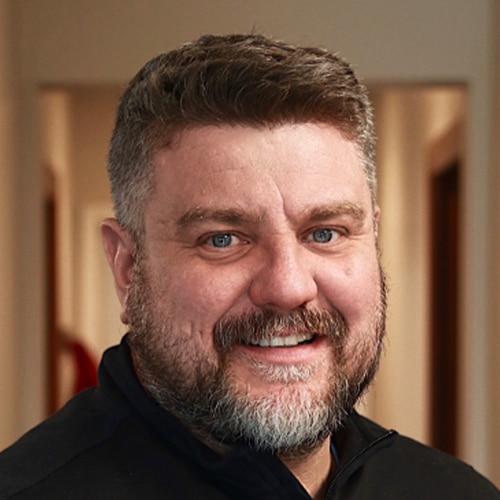
Mark Barglof is the President and owner of Kinetic Technologies, LLC, a robotic welding integration shop just north of Algona, IA. After serving in the military and earning the U.S. Army Ranger Tab, Mark shifted career paths and dove into the world of manufacturing. His vision is to build a full-service engineering and robotics company that can bring to bear all the advanced engineering tools to support their clients and make their concepts come to life quickly. They are intently focused on robotic welding integrations, robotic welding positioners and fixtures, and custom machine building.

